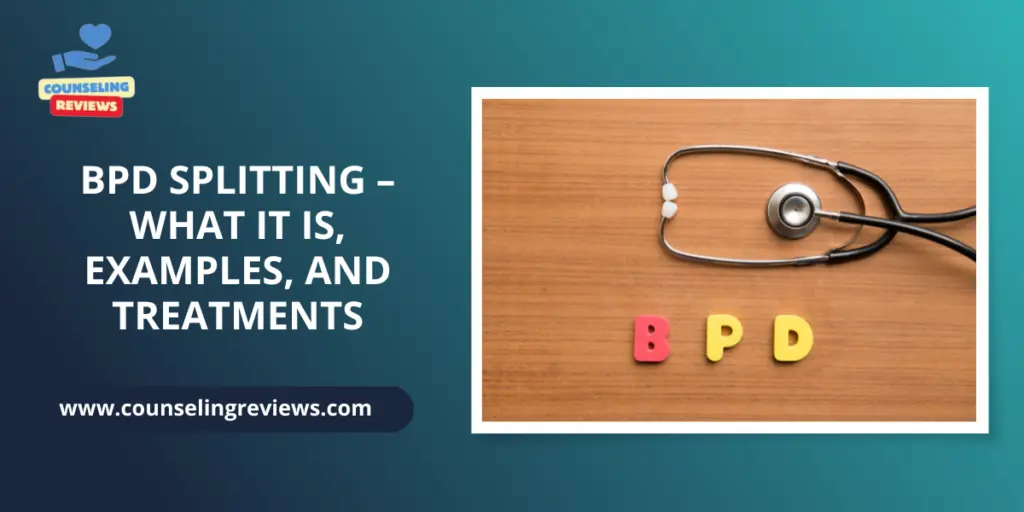What is BPD Splitting?
Borderline Personality Disorder (BPD) has had a lot of light shed on it in the last few years, making it less stigmatized and more understood, particularly in the mental health field. It is a full diagnosis in the Diagnostic and Statistical Manual of Mental Disorders (DSM) and is characterized as a personality disorder. According to the American Psychiatric Association, personality disorders are defined as when one’s emotions, actions, and thinking differ from cultural expectations and cause impairments in functioning.
A common symptom within BPD and other personality disorders is splitting. Splitting is a defense mechanism to protect one’s inner world and experiences. It is usually some sort of alternation between two different extremes, such as good and bad. Many people may describe it as changing on a dime or thinking or reacting in extremes.
What Triggers BPD Splitting?
When someone engages in BPD splitting, it is usually triggered by an extreme event that impacts their emotions or thought processes. Since everybody reacts differently and has different experiences, there is no one specific trigger for BPD splitting. Situations that trigger potential abandonment, judgment, or lack of acceptance can cause one to engage in splitting behaviors. Additional triggers may include experiences of being alone, as individuals with BPD struggle to tolerate this feeling, and situations where relationships, jobs, and other life factors are not stable and secure.
How to Know If It’s BPD Splitting? – BPD Symptoms
The DSM lists out symptoms of Borderline Personality Disorder as:
- Ongoing feelings of emptiness
- Experiencing emotional instability from day to day
- Attempts to avoid abandonment – whether real or perceived
- Unstable identity of self
- Impulsivity that is self-damaging
- Difficulties controlling anger and intense anger
- Unstable and intense interpersonal relationships
- Ongoing suicidal behaviors or self-harm
To be put in simpler terms, BPD characteristics also show up as difficulty maintaining relationships, constant emotional dysregulation, and struggles with self-image.
Splitting often occurs with BPD when someone struggles to hold two opposing thoughts, feelings, or beliefs. It can also be described as black and white or all or nothing, where someone identifies things as having to be one way or another, with no in between. Identifying splitting can be difficult, as we all think in black and white at one point or another. Noticing how often this is happening can give us hints as to whether it is splitting or not. Additionally, understanding the rationale for the all or nothing thinking is helpful to determine if it is splitting. When an individual splits, it is a defense mechanism to protect themselves and only focus on things they identify or view as “good”, even if they may not be.
BPD Splitting Examples: Real-life Scenarios
Take a look at some of these scenarios listed out to gain a better understanding of how splitting in BPD may look in reality.
- An individual may view someone in their family as “bad” and feel that they don’t matter to this person because of one negative thing that has occurred, such as one forgetting their birthday or not wishing them happy holidays. This individual does not acknowledge the neutral or positive moments they’ve had with this family member, including past birthdays where they have been celebrated.
- A teenager who engages in self harm may feel it is a positive coping mechanism because it alleviates some of the emotional pain they are having. They fail to recognize that they are hurting themselves in the process of making themselves feel better emotionally.
- Flip flopping back and forth on acceptance and rejection of others. A person who is splitting may act like they understand the intentions and decisions of a romantic partner and then say they feel rejected and denied by them in a very similar or the same situation.
- Instantly latching on to others who give praise or compliments to someone with BPD is another form of splitting. To the Individuals with borderline, they may see this person as good, supportive, and validating from one comment and cling to them in hopes they can continue to find validation from them.
BPD Splitting Treatment Options
Dealing with Borderline Personality Disorder and splitting can be difficult. It is normal for individuals with this diagnosis to seek help from trained professionals. Mental health therapists, psychologists, and psychiatrists can specialize in working with those diagnosed with BPD and provide helpful tools to overcome splitting.
Luckily, therapy has become more accessible throughout the years, making it less stressful to find additional support. Therapy also comes in many different formats. People seeking mental health treatment options can participate in individual therapy, in-person therapy, online therapy, and even group therapy sessions. Each option has its own benefits, so researching the best fit is always recommended for someone starting therapy services.
Is DBT Therapy The Right Approach to Heal?
A common modality used with BPD diagnoses is Dialectical Behavioral Therapy (DBT). This model of therapy was developed by Marsha Linehan and has evidenced based practices showing its efficacy with borderline personality disorder. DBT combines techniques and concepts both from Eastern and Western medicine, making it useful in various ways. A therapist trained in DBT can help individuals learn mindfulness skills to keep them in the present moment, interpersonal effectiveness skills for relationships, distress tolerance skills to help with intense emotions, and emotion regulation skills to keep emotions stable.
In traditional DBT, a client will have an individual therapist and will also attend group therapy sessions with peers. Additionally, they can receive phone coaching between individual and group sessions if they are struggling with risky behaviors or intense emotions. Learn more about how DBT differs from the CBT approach.
Conclusion
While BPD and splitting can be difficult to pinpoint and identify, there are ways to learn how to recognize these patterns and criteria. As stated before, splitting is a defense mechanism to prevent oneself from abandonment or rejection and tends to be a pattern in all relationships. There are many trained professionals who dedicate their whole life to supporting those with Borderline Personality Disorder, so help and support is out there. DBT has also been effective in working with BPD symptoms such as splitting.
If you or a loved one is seeking additional help, there are resources out there that are extremely beneficial.





